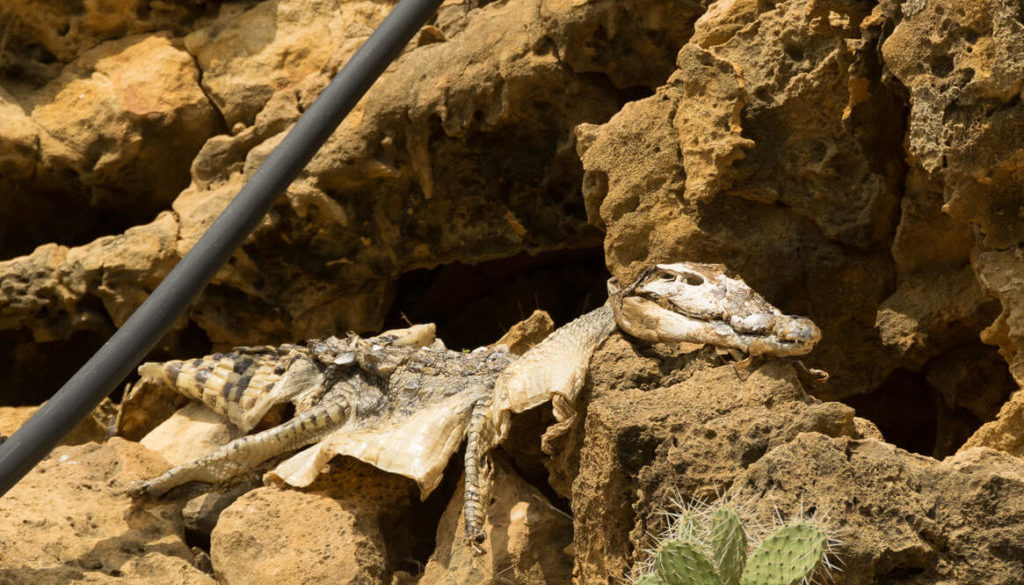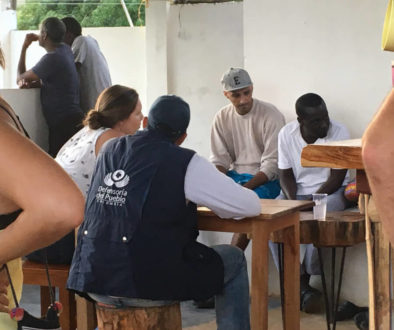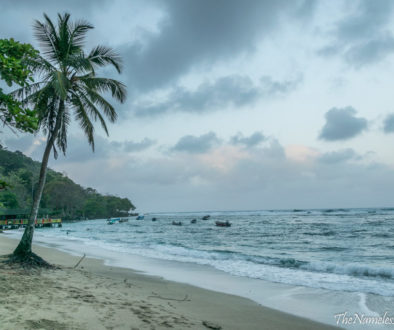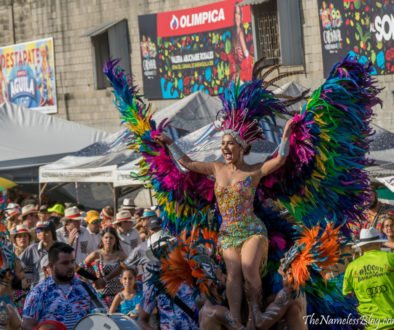Cabo de la Vela & Punta Gallinas
Cabo de la Vela & Punta Gallinas
So, you’ve decided to head over to the edge of the continent? Despite the distance…despite the heat and lack of tangible luxury…despite the stories of danger I’m sure you’ve heard by now?
….what a great decision you’ve made. Buckle up your safety belt. You’re in for an adventure.
If you’ve decided to head for the continent’s edge your next decision is to tour or not to tour?
My advice is to travel to Cabo de la Vela independetly with my “how to” guide.
From there you can hire a local to take you the rest of the way to Punta Gallinas.
It’ll save you some cash and heighten the whole experience by ten fold.
If you’d rather take a traditional organized tour, you can do so leaving from Santa Marta or Riohacha. One of the highly recommended agencies is Alta Guajira Tours.
Arriving to Cabo de la Vela
We climbed out of the final colectivo along the main road in Cabo just after sunset. First thing we noticed was the horde of people.
What the heck?! I thought. Wasn’t this one supposed to be off the beaten path?
Chances are if you’re reading this online then it hasn’t been a secret for quite a while.
And if you’re traveling during December like we happened to be keep in mind that the universities are closed. December is prime time for Colombian travel.
Any other time of the year and the place should be much more peaceful.
We continue up the road stopping at potential lodgings. Honestly they all look very similar and offer the same rustic accommodations. Hammocks, tent space and rustic styled rooms in thatch type buildings.
We continue walking for about 15 minutes nearly to the end of the road. Here the crowds had drastically died down. We scored a camping site at Kite Addict for $10,000COP (~$3USD) per tent.
*If you continue up past the main road along the coast to the left you’ll find the best accommodations. Secluded and with much more open space. They are in much better shape than must of the places you find along the main road. It’s quite a walk from where the transport drops you off. Say, 30 minutes or so by foot. Or catch a ride with a mototaxi for a few pesos. I recommend Rancheria Jareena.
What to Expect
Understand that the entire region is rustic. Leave your wifi addiction in Santa Marta.
There is no running water or free flowing electricity in the town. All bathroom facilities are with the sea water. Any electricity is from gas powered generators.
When looking for your place to stay. Make sure to ask if they have a generator running at night. Some places don’t and you’ll be left to candlelight.
We pitched our tent where we estimated the sun wouldn’t hit early in the morning and headed out to get dinner.
The best food we found was Nomade. A simple place with a great happy hour menu.
It’s also where we learned about the electricity poles that lined the street.
Cabo’s Social Struggle
No running electricity? What’s up with those power lines I thought.
According to our Argentinian waitress the poles were mounted by a government lead social project to bring power to the community.
Long story short the funds “went missing” and the project was never completed. The poles are nothing more than disappointing decoration at this point.
Chatting with some locals and the belief is that corruption is to blame. This region is home to massive coal mining and should among the wealthiest in the country.
Well, it’s more than obvious that the profits don’t make it back to the region.
Back to our tent we go, this day is all but over.
Securing a ride to Punta Gallinas
We wake up bright and early, take a stroll along the beach. It’s beautiful. It’s peaceful. My eyes see it but my mind has trouble comprehending it. It’s almost as if time is standing still as I stare off into the distance.
The silence only broken by my grumbling stomach. We head over to find some breakfast. Where we run into the Colombians that we arrived with and two travelers become four.
We all sit down together. Eggs, toast and fruit all around. When we are approached by a man offering to drive us to Punta Gallinas. $150,000 each he says.
Back and forth we go. $100,000!!!
No, $140,000!!! He says.
I continue the bartering “Somos mochileros no millonarios”!!!
Which basically means we are no frill travelers with small budgets. Trust me, it sounds much more convincing in Spanish. HA!
He breaks out into a hysterical laugh and we shake on $120,000COP ($40USD) each.
You’ll have no trouble finding your own transportation. Transport to and from Punta is a main source of work for the people living here.
Picking a Driver Checklist
- Most importantly my advice is not to pay any money up front.
We decided to to spend the rest of the day in Cabo and head out the next morning. The driver requested half the money. We negotiated to pay half once we were in the truck on our way. - Ask to see the set of wheels ahead of time.
There are all types of trucks running the route. Some very good vehicles and others that appear on their last leg. I wouldn’t agree to the ladder vehicle option. - Ask about air conditioning!!!
That’s right, this one is important enough to get it’s own line. A/c is important! The road is very dusty. If your ride isn’t air conditioned then prepare for hours of eating dirt with the windows down. - Ask in detail what is included in your price.
For us this included the ride to Punta Gallinas. The short boat ride across the channel. Rides to three attractions in Punta. And a return ride to Uribia. - Our price did NOT include.
Accommodations or food. Nor did it include the $10,000 COP ($3USD) admission to one of the sites in Punta. It’s also possible to negotiate visiting a few attractions close to Cabo in your deal for a slightly higher price.
Cabo de la Vela, Day 2 continued
After breakfast we decided to head over to see some of the local attractions. Jimmy, our would be driver offered to take us for an additional fee. We were lucky enough to have a good bit of cloud coverage so we opted to save the money and walk.
We grabbed our sunglasses, hats and water and headed up the coast.
The further we walked along the dirt road the more the land opened up.
The land rolled and rolled until we couldn’t see it anymore.
In the distance, the rolling hills of dirt and rocks ran right off of the cliff into the sea in a blazing pastel of colors. Almost like someone’s paintbrush left them there.
El Faro de Punta Gallinas
First stop, the lighthouse.
My first impression? This isn’t a lighthouse!
It’s more like some slabs of metal topped with a light. I guess it does everything a lighthouse should do…
…But I was ready to climb the spirling steps of the castle-like lighthouse of my imagination!
Feeling a little disappointed, I drag my feet up to the lighthouse’s hilltop.
BAM!!!!
Now it all makes sense, no one care about this lighthouse. People come here for the cliff edge views. Stunning!
I’m all smiles again. Plus we made a new friend.
Ojo del Agua
We stop and buy some water and snacks at the base of the hill. We cool off in the shade for a bit and then we take off again along the coast.
Ten minutes later we arrive at Ojo del Agua, a small beach. It’s beautiful and the perfect place to cool off further.
There are also a few really nice vantage points around the beach. We take a stroll and are treated to pure beauty.
Playa del Pilon
This is a another really nice beach quite a way further along the coast. Our group of four got a really late start heading over after Ojo del Agua. As the sun started to come down we decided to turn back and enjoy the sunset at the first beach.
If you budget your time better than us, all accounts of Pilon are top notch.
We turn back and make it just in time.
In the background we can see the lighthouse. Turns out that’s the popular sunset place. It’s flooded with trucks and people. While we share the beach with a much more intimate crowd.
The Route to Punta Gallinas
The next morning we meet Jimmy at the restaurant at 6am. To our surprise he’s already there.
Wait, what?! Jimmy doesn’t run on South America time? 🙂
Hola Jimmy, lets go!
Oh wait, where’s the truck?!
Turns out Jimmy runs on time but his tune up mechanic doesn’t.
No worries, after traveling South America for about a year now I’d assume something was wrong if we did leave on time.
7am rolls around and we are on our way. We make it about ten minutes until we run into a convoy of other trucks.
All the drivers are huddled around a truck trying to get it started. Jimmy jumps out the car and joins them. At first no big deal.
But after the first hour…and then the second hour…
we grew restless and honestly a bit irritated. We paid our money for this truck, the broken down one looked older than myself. The people should have did their research!
Remember that checklist I gave you guys above? If you skimmed it, go back and read it. It’s probably the most important info in the entire post.
Finally, the ignition turns and the truck roars back to life. Everyone jumps into their ride and off we go truck after truck along the dirt path.
The people of the region: The Wayuu
Generally, the further you get away from the cities the harder the way of life becomes for the people in the developing world. This is very true of Colombia. Cabo de la Vela & Punta Gallinas are proof .
The disparity between cities like Santa Marta and Cartagena compared to Cabo is drastic to say the least.
But then comes the disparity of Punta Gallinas and the small villages along the way. Never in my life have I seen a people with a way of life quite like this.
The barren dry land makes it very hard to grow crops. There is no local industry available to the people here.
The people in Cabo get by primarily by offering meals, accommodations and kite surfing lessons. But what about the people living in between Cabo and Punta Gallinas?
There are tiny communities of shanty houses along the barren landscape between the two destinations. These communities survive mostly by the donations of travelers.
Wayuu Enforced Taxation
The young, the old and every age in between make road blocks outside of their homes. This is the primary source of “work” here. From children so young they barely stand taller than your kneecap all the way up to weatherbeaten grandparents. It’s passed from generation to generation the same way a fisherman teaches his children to fish or a farmer teaches to farm.
They block the road with rope, chains, shirts tied end to end or anything they can get their hands on.
It’s expected that you pay to pass the toll. Pay with anything, food, snacks, candy, money or beverages.
We had heard about this from the hostel owner in Santa Marta. We brought along a few bags of candy, much like we do on all of our hikes.
Our plan started off a complete success but shortly later we realized we were completely unprepared.
There were at least 20-30 roadblocks!!! Some just feet after one another.
We quickly ran out of candy.
Then we ran out of coins.
Next we started giving away our water.
That ran out too. Jimmy bartered with the remaining tolls to get us by without payment.
I still have trouble wrapping my head around the situation. There was so many more people in this situation than I could have ever imagined.
Be prepared for a few uneasy feelings, I think anyone with a heart will feel for their situation.
Crossing the Channel
The road continues and after 3 hours or so you’ll arrive at the channel. Here we board a small boat to cross the aqua blue waters. Beauty is all around. The cactus run into the orange dirt that lines the Earth and bleeds into the enchanted waters.
Once again I think to myself, I’ve never seen a place quite like this…
Another one of those fairytales come true. An enchanted land far away from the rest of the world. It’s a place so beautiful you won’t believe it until you see it.
No picture could do it justice.
Accommodations
The boat takes us to the front steps of Hostel Alexandra. The place has a rustic charm. If you’re coming via local driver than you probably don’t have any other choice.
We had heard that this is the only accommodation in the area. Turns out that’s not true. The drivers pretend it is because this is the only hostel that provides a free bed and free meals for the drivers.
We paid $10,000COP ($3USD) for a camping space. Hammocks cost $15,000COP ($5USD). Rustic thatched rooms available as well.
Electricity is available in the dining area.
All running water is tapped from the sea.
Scheduled meals costs around $20-30,000COP ($8-10USD).
Exploring Punta Gallinas
Included in the original negotiated price includes a tour of the local wonders. This tour is in nice comfortable trucks and lead by the staff at the hostel.
The Mirador
– a cliff edge for the perfect selfies.
Dunas de Taroa.
-where the desert sand dunes run off into the sea. There has been some hostility about this location in the recent past. As I understand it the people living close by feel that only the hostels benefit from the tourists in this area. This has lead to locals fighting among themselves.
The agreed upon solution has been to charge visitors $10,000COP ($3USD) to access the site. Reports that you’ve heard about the dunes being closed are not true. They are just patrolled by another set of locals and aren’t included in your original price.
Faro de Punta Gallinas
-this is the reason you’ve traveled so far. The geographically end of the continent. Following the dunes we drove to the lighthouse. The guide pointed us to a small wooden cross. Nothing more than a pair of decaying wood pieces and at that moment we knew we had made it.
The northernmost point of South America.
I was ecstatic, the same feeling an astronaut would have with their first step onto the moon.
Every action and every second of the journey was more than worth it.
We sat around in silence watching the sun fall. My only thoughts are that of thanks. Thankful to be here in this place at this exact moment. Nothing else mattered.
When I left home almost a year earlier it was insearch of something I felt was missing…
I think I found a small piece of what was missing in that moment. A moment I’ll never forget.
The Road Back
Early the next morning the rocks crumbled under our shoes as we walked to the nearby beach. Just over the hill we could see the waves crashing against the shore.
We spent the next hour or two collecting seashells and enjoying the breeze.
Afterwards, the four of us headed back and had breakfast.Then we boarded the boat and shortly later traded that for the waiting truck. We paid Jimmy the rest of the money so that he could pay for the boatman and we were on our way.
Most of the other groups had left out already. So we starting along the dirt road on our own.
Not 30 minutes into the drive the truck cut off and puttered to a stop.
My face dropped and my heart sank as Jimmy tried to restart the ignition. Nothing!!!
Our group climbed out, no shade in sight.
Karma Works in Mysterious Ways
Instantly I felt like karma kicked me in the face. All of that complaining I did when we were waiting two hours to get the other truck up and running.
Well, now I know why the drivers travel in groups. They stop and help each other if any trouble happens.
They are a tight community and one never knows when they’ll have the misfortune of breaking down.
After 30 minutes pass I nearly come to terms with the idea that I might have to drink my own pee if we are out here for too long when we see another truck coming our way.
They stop and get the truck started.
Yessss!!! I won’t be forced to drink my own pee or wrinkle into a dehydrated prune.
We’re on our way now. A/c blaring. Life is good again.
As we continue to drive the truck starts to have some power issues, we fall further and further behind the other truck until it disappears into the distance.
Our Second Breakdown
Nooooo, please not again! I don’t want to drink my own pee 🙁
This time we breakdown just before a Wayuu toll. I think to myself where the heck did you guys come from? We are literally in the middle of nowhere. Not even a village in sight.
The kids run over and help us push start the truck. Once, nothing,
Twice, nothing.
Third time a charm? BAM, the truck starts up. We empty whatever money we have left and give it to the boys.
We hop into the truck and drive like maniacs. We’re making good time, smashing over the bumps and hills.
And then it happens again. The truck shuts off and we slow to a stop.
Broken hearts all around.
We all die a little inside. Almost enough to make you cry but that would only lead to dehydration faster.
Jimmy works on the truck but it doesn’t give.
After another hour or so we see another truck headed in our direction.
They pull up to us and lend a hand. Long story short our truck never starts up again. The good samaritan negotiates a price with Jimmy to tow us back to Uribia.
To be honest we were a little afraid that Jimmy would try to charge us extra to cover the tow job. But that never came up.
We arrived in Uribia much later than we expected to but all that mattered is that we made it without having to drink our own pee.
That’s a win in my book.
Afterthoughts, Cabo de la Vela & Punta Gallinas
If Cabo de la Vela is the cake, then Punta Gallinas is the ice cream. You can’t have one without the other. They go hand in hand.
It’s an adventure among adventures.
A true bucket list destination.


































